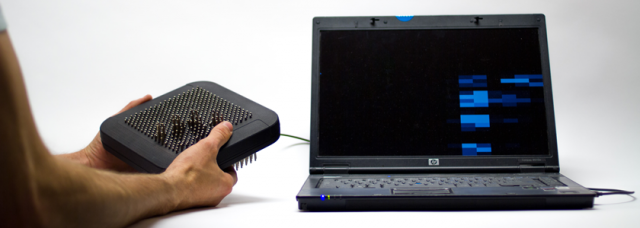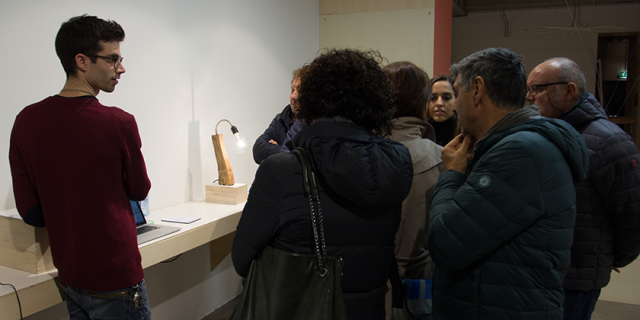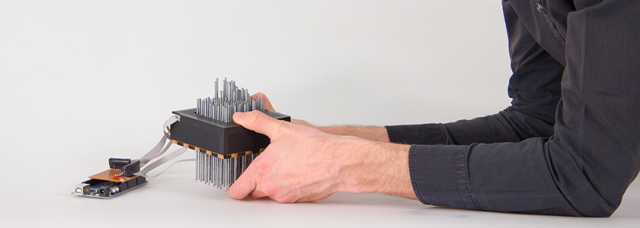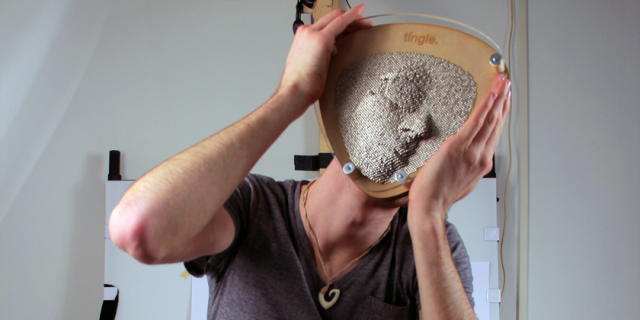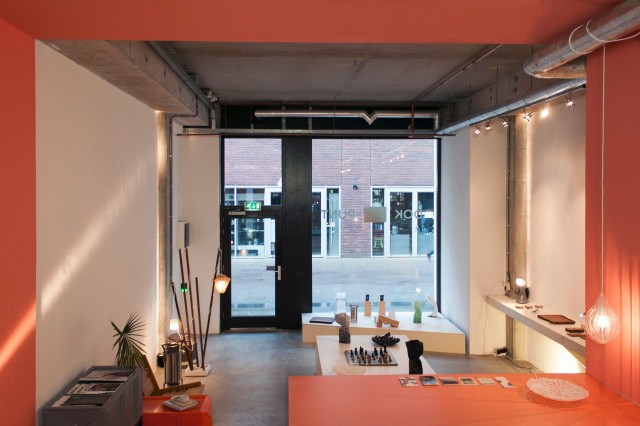[vimeo width=”640″ height=”360″]109389202[/vimeo]
It looks like Pin Art or Pinscreens – those moldable frames full of pins popularized in the 80s. But the result is something that lets you dig your hands into sound and musical structures in new ways. It looks expressive and, let’s be honest, really fun.
(For the research minded, there’s also a NIME report below.)
From the edge of the Netherlands’ slick design scene, industrial designer and music technologist Arvid Jense joins CDM for a series of interviews with Eindhoven Music Startups. Here’s his encounter with Nupky.
Eindhoven Music Startups: Nupky
Rhys Duindam is a graduated Industrial Designer from TU/e. Through Nupky, he is creating a tangible music controller which aims to bring back a the acoustic touch and feel to digital music creation. Inspired by a pinscreen, the Tingle will let you mold sounds with your hands or anything else. A release date is not yet available.
How did you come to make your product?
If you look at most digital music gear it uses sliders, knob and buttons to control sound. These were basically the only available interface elements at the time synthesizers were developed. But because of this, we have lost most of the acoustic qualities of music instruments. Digital instruments have their own strengths, but the acoustic experience of a piano or guitar is priceless. With Tingle I am trying to recapture that acoustic experience in electronic instruments.
Most of the product I developed myself, but how I got there was through the help of my coach Hans Leeuw. He pointed me towards the right sources and pushed me to continue Tingle rather than moving on to a new project. For this I am grateful.
Tingle consists of:
- pressure sensitive pins (which are spring loaded so that they push back on your fingers)
- an accelerometer (to detect things like shakes and thereby create whammy bar-like effects)
- and vibration motors (so you feel what’s happening with the sound, a bit like the vibrations in the body of an acoustic guitar against your own body).
What I want is for a Tinglist to have a specific role in a band. For example; the soundscape player of the band. This would be lost if I would make Tingle an all-in-one device. So I am orchestrating specific software synthesizers to be made, which the Tingle then controls. We might add MIDI control later as a secondary function, once all the control subtlety has been brought in.
It can certainly be interesting to combine all components of music under one controller, like DJ’s have it, but then that would be the specific characteristic of that controller. But if a player wants to be in control of a specific role in the song composition (like a guitarist would), you’re going to feel very limited. Personally I think that more digital instruments should find their specific sound/play character.
A good example is Ableton Push. It might initially look like it is just a grid of buttons, but it is very well thought out. There is a specific character with which it integrates with the software, so that music production finally feels like you are playing a musical instrument again, and not controlling variables. I think this is a huge step into the right direction.
What are your future plans?
There is no fixed deadline to the release Tingle, but we hope to make the five looks-like feels-like prototypes with a synthesizer within a month. These will be fully functional and will be given to a number of musicians to see what can still be improved before Tingle goes into production. Hopefully before the end of the year I can sell the first units. But things always take more time than you would expect, so who knows it might be next summer.
I want to sell Tingle for about €400. It should be a lot cheaper than specialty controllers like the Haaken Continuum, and more in the price range of a multi-effects pedal, because I want everybody to be able to use it. But first I have some hurdles to conquer before that is possible. The biggest issue right now is that each Tingle needs 512 pins. For 5000 tingles, that would mean we have to make over 2.5 million pins, put springs on each pin and insert them into Tingles. It takes a lot manual labor to do this.
In the meantime, we are looking at different mappings of the grid to sound; be it zoned or more blob/molding-like. We hope to be able to switch from a sound-building mode to a sound-playing mode. In build mode, you’ll be able to mold the synthesis parameter with your hands, and following this you can play your sounds in play mode. So if you want to switch to a solo sound, you just have to remember the shape to play it.
Mark IJzerman is one of the sound designers working with me on Tingle. He made the very first soundscape for Tingle, which at that time was a plugin for Ableton in which you had a grid that was coupled to a musical scale. This meant that wherever you pushed, you got a bunch of complementary notes and that always sounded good. This was important as a demo because we wanted to show that everyone could make great sounds with Tingle.
Mark is now working with Andreas Lo-A-Njoe, our sound programmer, to transform everything you do with Tingle into directly logical sounds. So that you feel like you are getting the sounds you intended; such as subtle sounds when you use the tips of your fingers or bombastic sounds when you push your full hand into it with force. This very likely would mean that we will step away from the grid mechanic, as it is too static for such a dynamic interface as Tingle.
Diemo Swarz, researcher / developer at IRCAM, modified CataRT for Tingle. CataRT is a software he wrote which splits a sample into many grains, and then places similar grains next to each other in a 2D grid (much like the pins are oriented on Tingle). So when you press somewhere in Tingle, you will get a group of sounds which all sound similar. For example, a sample of fire crackling will make it feel like you can really play and control fire. Super cool stuff.
[vimeo width=”640″ height=”360″]https://vimeo.com/119138523[/vimeo]
The creative team Ethno Tekh, from Melbourne, is also writing something for Tingle using their own granular synthesizer – Grain Plane. With this it will feel like you are playing moving echo’s. Really great stuff.
But this is only in music. Since Tingle is a sensor, it is a tool. It can be used for anything that takes queues from a computer. I know I will be working on some VJing applications in the near future.
Why are you doing this?
It might sound silly, but one of my main motivators was seeing that a lot of [industrial design] student projects just stay as ideas. A lot of people have had super awesome concepts, which just died. So I felt like we needed role-models who succeed in bringing their projects to market. And I must admit, by doing it I understand why it doesn’t happen more often; it’s just really difficult.
It’s difficult because what I’m doing is what they call a boot-strapped startup, which basically means you’ve got no money at all. You have to manage everything yourself. I’ve invested more than €18.000 into Tingle up until now, which is paid for by teaching, making videos and doing other jobs on the side. The only things I pay for are food and rent. And everything else goes into my company.
Next to this, my vision is about helping people with their self-esteem through playful and magical interactions. I used to be very introverted and nerdy. I was bullied and had terrible self-esteem. Over the years I got past this, but when I look back, I think, why did I live like this? Most people suffer from self-esteem, and this holds them back. So many people with great talent, who underestimated themselves, never fulfill their potential. Design is just my medium, through which I hope to show people that they are better than they know. I like to quote Edmund Burke: “The only thing necessary for the triumph of evil is for good men to do nothing.”
What do you think design thinking brings to electronic instruments?
When I look at the electrical engineers, I really feel like I’m not smart enough. Engineers are really smart people. But my focus is on the beauty of interaction, on the ways people use things. Engineers have a talent with programming and building the most fantastic and crazy technological things, but quite often these things miss the human aspect. Some even embrace non-humanness. For instance I recently saw an instrument which had a body frame with connected gloves, arms, head, going all around the body. Which is cool! But most people in the world are not looking forward to putting on a robot suit to play music. Engineers often work from what is possible, “yes this is possible and this and that”, while a designer will say “Why this? And why that?”. I guess that is the difference.
But I think a lot of designers can be a bit arrogant, thinking our way is the Holy Grail to save the world. Bullshit. It’s through partnerships of different people that you get truly awesome things. Put aside the ego. Technical people make crazy innovations, we designers bring the human aspects to technology and business people ensure that those things succeed in the real world.
How do you deal with investors?
I wanted to start with a Kickstarter, but I didn’t feel confident that I could get enough people interested in a short time. It’s not like people stumble upon your Kickstarter and spontaneously decide to invest. It’s only when two thirds of your project is funded that it gets traction. And at the time I tought, I’m no salesman. I’m a designer and an inventor.
So to ensure the project arrives on the market, I’m now working with Ad van Berlo and Joost van Dijk to fine-tune the product and business. Joost will help with the business plan and negotiations, Ad will get Tingle manufacture ready, and I will take care of the experience, service and vision.
To prepare for this, we teamed up with two young entrepreneurs (FRANS prototyping) to developed a new sensor for Tingle; and these guys are wunderkinds. They’ve transformed the old sensor I’ve developed into something six times faster, making it zero latency, having a 100% improvement in signal-noise reduction, and removing a lot of the earlier bugs. Also our two sound designers Mark IJzerman and Andreas Lo-A-Njoe are hard at work!
Is your product Open-Source?
I’ve gotten a patent on the technology of the Tingle; which takes a lot time & money and I don’t really agree with the principle, but I need it as a negotiation tool. I would like to let my patent be open to use for experimentation and the furtherment of knowledge, but malicious companies who just want to copycat my product also need to be considered.
All in all I’m a big supporter of open-source technology. All software will be published as open max/msp or puredate objects, so users can make their own patches with it. The danger however when making open-source products is that I won’t get a return on my investment, so I won’t be able to continue making more products like this. I’m still figuring out how to do this correctly. I might need to find a job on the side. I always choose for my vision over money, but at some point money will become an issue towards that vision.
Together with Diemo Schwarz and Hans Leeuw, I’m writing a paper for NIME. In the article I explain all the design and technical aspects of Tingle; how it works and how you can build it yourself. All theories of giving electronic instruments more acoustic properties are also discussed. Basically a summary of the one and a half years of knowledge I’ve gained on this project so other people can also make use of it.
I publish it because I want to see the things made by the crazy genius of technology savvy people who can take my ideas to a level which I can’t reach. I believe in the power of many, and the more people who have access to a technology, the more interesting the results will be. To keep this alive I will be making a website on which you can share the creations you make with the Tingle, whether it is a soundscape or a VJ controller. Should be great!
How is Eindhoven for you?
I’ve often considered other places. In fact, just after graduating I wanted to go to San Francisco, just for skateboarding and the sun. The Dutch weather doesn’t really match with my sports passion. I stayed because I have a great network in Eindhoven. The Dutch government supports young companies decently and Eindhoven is quite often seen as a next technological world center. We’ve got all creative and skilled people around us. I’ve joined the Designers collective DOK.PUNT and I could 100% recommend joining a collective like this if you are an independent designer. Because this way you will always have people around you to discuss ideas with, or find out things if you don’t know the answer, and this actually happens constantly.
Eindhoven is also crazy full of starting companies; you can feel the energy in the air like electricity. There is a bubble of creative energy here which will explode at some day. OWOW and LunchBox synths are some of the other people making instruments here in Eindhoven. So there is always someone to spar with.
What is the future of music?
We can break our need for traditional instruments now, because we as generation Y have grown up with technology. We fight for our individuality, and we are constantly looking to the future. There are a lot of artists also looking for new ways to make their style unique. So I don’t think it’ll be a problem for new instruments to be accepted. But we do have to take care that it won’t become a gadget economy. A box with sixteen knobs and samples won’t be enough anymore. The objects will have to become real musical instruments, which allow you to use a range of skills to make music.
Tingle has the advantage in this because it a ‘wanna-have’ object; you just want to touch it. Some children at a demo recently were playing with Tingle for at least half an hour whilst telling their parents that they would rather have a Tingle than an iPad for Christmas. A pretty good indication I would say that they liked it.
Tingle at NIME
Tingle was a featured presentation at this year’s international New Instruments for Musical Expression (NIME) conference, held a few weeks ago at Louisiana State University in the USA. The project is available as part of the NIME proceedings (with a free PDF) if you care to learn more:
Tingle: A Digital Music Controller Re-Capturing the Acoustic Instrument Experience
Rhys Duindam, Nupky, Eindhoven University of Technology,
Diemo Schwarz, ISMM team, Ircam–CNRS–UPMC
Hans Leeuw, Electrumpet, University of the Arts Utrecht, University of Huddersfield
